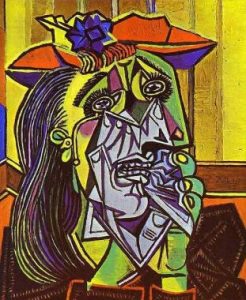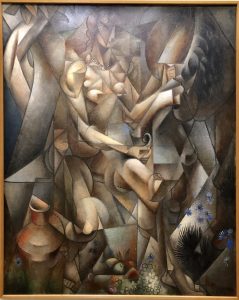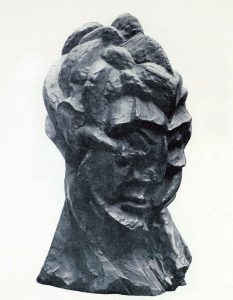Cubism was a new approach to representing reality invented around 1907–08 by Pablo Picasso and Georges Braque. They brought different views of subjects together in the same picture, resulting in paintings that appear fragmented and abstracted.

Image source: https://search.creativecommons.org/photos/a953ecfc-352d-4dee-87ba-a8fabff24aa0 Author: NichoDesign
Cubism was one of the most influential styles of the twentieth century, its beginning can be traced back to around 1907 with the famous painting by Picasso Demoiselles D’Avignon which included elements of the cubist style. The name ‘cubism’ derives from a comment by the critic Louis Vauxcelles after seeing some paintings by Georges Braque exhibited in Paris in 1908, and he described them as reducing entirely to ‘geometric outlines, to cubes’.
What inspired cubism?

Image source: https://search.creativecommons.org/photos/e0a96a41-8f07-45b8-9671-0c98243e0be3 Author: y.caradec
Cubism was partly influenced by artist Paul Cézanne’s latest work in which he paints things from slightly different points of view. Pablo Picasso was inspired by African tribal masks which despite being stylized still present a vivid human image. ‘A head’, said Picasso, ‘is a matter of eyes, nose, mouth, which can be distributed as you wish’.
Analytical cubism

Image source: https://search.creativecommons.org/photos/0456ea13-6f18-4209-ab66-fcd09932cf1eAuthore: George M. Groutas
The development of the movement from 1910 to 1912 is often referred to as Analytical Cubism. During this period, Picasso and Braque’s works became so similar that their paintings are almost indistinguishable. The Analytic Cubist paintings of both artists show the decomposition, or analysis, of form. They simplified their color schemes to an almost monochromatic so as not to distract the viewer from the artist’s primary interest—the structure of form itself. The monochromatic color scheme was suitable for the presentation of complex, multiple visions of the object, reduced to opaque and transparent overlapping planes. Forms are generally compact and dense in the center of an Analytic Cubist painting, enlarging as they spread toward the edges of the canvas, as in Picasso’s Portrait of Ambroise Vollard (1909–10).
Synthetic cubism

Image source: https://search.creativecommons.org/photos/b46b5509-3390-4b2d-98a6-9d41f8801688 Author: George M. Groutas
Around 1912, the styles of Picasso and Braque begin to become predictable. Their images were so similar that their paintings from this period are often difficult to distinguish. Their work was increasingly abstract and less recognizable as the subject of their titles. To revitalize the style and pull it back from total abstraction, Picasso began pasting printed images from the ‘real world’ onto the surface of his still lifes. The first example of this ‘collage’ technique was his painting ‘Still Life with Chair Caning’ which opened the doors to the second phase of the Cubist style: Synthetic Cubism. Influenced by the introduction of bold and simple collage forms, Synthetic Cubism moved away from the unified monochrome surfaces of Analytic Cubism for a more direct, colorful and decorative style. Synthetic cubist images appear more abstract in their use of simplified forms, although the other elements of their composition are applied in a fairly traditional way.
Cubism in sculpture
Cubist sculpture developed parallel to Cubist painting. In the autumn of 1909 Picasso sculpted Head of a Woman (Fernande) with positive traits represented by negative space and vice versa. The firts sculptor in Paris to join the Cubist was Joseph Csaky, after Archipenko, with whom he exhibited from 1911 onwards. Later joined Raymond Duchamp-Villon and then in 1914 by Jacques Lipchitz, Henri Laurens and Ossip Zadkine.

Image source: https://en.wikipedia.org/wiki/File:Pablo_Picasso,_1909%E2%80%9310,_Head_of_a_Woman_(Fernande),_modeled_on_Fernande_Olivier.jpg
The Cubist construction was as influential as any Cubist pictorial innovation. It was the stimulus behind the proto-Constructivist work of both Naum Gabo and Vladimir Tatlin and thus the starting point for the entire constructive trend in 20th-century modernist sculpture.
Info sources:
https://www.tate.org.uk/art/art-terms/c/cubism https://www.britannica.com/art/Cubism https://en.wikipedia.org/wiki/Cubism http://www.artyfactory.com/art_appreciation/
